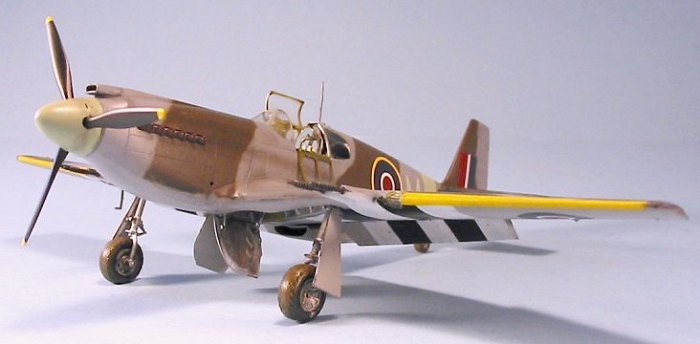
|
KIT: |
Accurate Miniatures P-51/51A Mustangs |
|
KIT # |
3401 / 3402 |
|
PRICE: |
£ |
|
DECALS: |
one option per kit |
|
REVIEWER: |
|
|
NOTES: |

|
HISTORY |
Everyone "knows" that the Mustang was the airplane designed and built in 120 days for the British because North American's Dutch Kindelberger didn't want to build Curtiss P-40s under license, and that the first Mustangs were a disappointment because they were hobbled by the godawful Allison engine, and that the airplane only became "good" when it was powered by the mighty Merlin. Right? That's the stuff in all the Mustang books, isn't it?
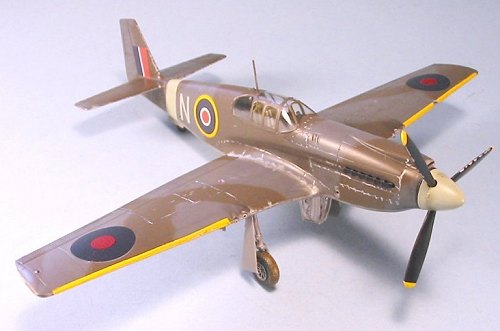 Well, yes, all
that is in the "history books," many of which are written by people who
prove the old saw that if you copy from one it's plagiarism, while if you
copy from many it's research; and if the many have copied from each
other, mistakes can indeed become "facts." We are only now, sixty years
after the events, starting to discover that a lot of what was written as
history at the outset was "uninformed" to be generous, and then was
copied by those who followed, to the point that it became "the truth"
because it had been repeated so many times.
Well, yes, all
that is in the "history books," many of which are written by people who
prove the old saw that if you copy from one it's plagiarism, while if you
copy from many it's research; and if the many have copied from each
other, mistakes can indeed become "facts." We are only now, sixty years
after the events, starting to discover that a lot of what was written as
history at the outset was "uninformed" to be generous, and then was
copied by those who followed, to the point that it became "the truth"
because it had been repeated so many times.
Here's a truth from the horse's mouth about the origins of the Mustang: in 1981, Edgar Schmued, designer of the Mustang, came out to Chino for a 40th Anniversary celebration of his most famous work at The Air Museum, "Planes of Fame." Mr. Schmued began his career at the Bayerische Flugzeug Werke in Munich in 1934, and left in late 1937 when certain political idiots started investigating aspects of his family history. (Thank God, if World War II had to be fought, we got to fight the morons of the Nazi Party.) As a young engineer, Schmued had been involved in most of the detail design work that went into the creation of the Bf-109. "I was working on a fighter design of my own all that time, refining it with new information, waiting for an opportunity," he said. "Yes, the Mustang was built in 120 days, but I had been designing it for five years."
Furthermore, Dutch Kindelberger knew about Schmued's filing cabinet full of drawings, and had a strong hunch it was a pretty good design, at the time he turned down the British offer to fund North American's license production of the P-40, an airplane Kindelberger correctly saw as being at the end of its development cycle. It might be a fight to turn the drawings into blueprints inside 120 days, but they were not starting with "clean paper" as everyone has believed all these years since.
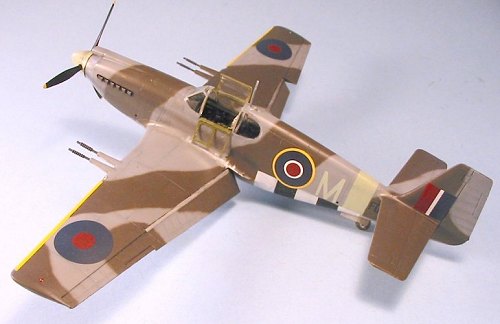 So far as the
Allison-powered Mustang being a "disappointment" is concerned, Southern
California aviation legend the Rev. B.C. Reid - who flew every kind of
Mustang there was with the 107th Tac Recon Squadron of the 67th Tac Recon
Group during 1943-45 - told me that the P-51A Mustang was to the Mustang
series what the Bf-109F was to Messerschmitt's fighter: the best
combination of engine and airframe for flight harmony. "After the
A-model, they kept adding weight more than they added power," he once
told me, "and the D-model was an underpowered truck in comparison with
the A-model. Its only grace was it could fly high." The 107th TRS kept
F-6As (the photo-recon P-51A) to the end of the war, and pilots like Reid
chose to fly them over the F6C (P-51C) or F6D (P-51D) whenever possible,
"because you could outperform anything under ten thousand feet in that
baby." In terms of performance, when an RAF Mustang IA was test-flown
against a captured Fw-190A, there was little to choose between the two up
to 23,000 ft. and the Mustang could outrun the Focke-Wulf below 15,000
ft.
So far as the
Allison-powered Mustang being a "disappointment" is concerned, Southern
California aviation legend the Rev. B.C. Reid - who flew every kind of
Mustang there was with the 107th Tac Recon Squadron of the 67th Tac Recon
Group during 1943-45 - told me that the P-51A Mustang was to the Mustang
series what the Bf-109F was to Messerschmitt's fighter: the best
combination of engine and airframe for flight harmony. "After the
A-model, they kept adding weight more than they added power," he once
told me, "and the D-model was an underpowered truck in comparison with
the A-model. Its only grace was it could fly high." The 107th TRS kept
F-6As (the photo-recon P-51A) to the end of the war, and pilots like Reid
chose to fly them over the F6C (P-51C) or F6D (P-51D) whenever possible,
"because you could outperform anything under ten thousand feet in that
baby." In terms of performance, when an RAF Mustang IA was test-flown
against a captured Fw-190A, there was little to choose between the two up
to 23,000 ft. and the Mustang could outrun the Focke-Wulf below 15,000
ft.
The first Mustang Ace wasn't even flying a Mustang! 1LT Michael T. Russo of the 522nd FBS shot down five German aircraft between September 13 and December 30, 1943, while flying something its pilots called an "Invader." The A-36A was always a "Mustang", though Lt. Robert B. Walsh of the 27th Fighter-Bomber Group is generally credited with suggesting "Why don't we call them 'Invaders' since we're always invading places?" Since that name was chosen for the Douglas A-26, pilots were told to stop referring to their Mustangs as such. For an airplane that wasn't even a fighter, the A-36s of the 27th FBG managed to shoot down 53 German and Italian aircraft between their introduction to combat in June 1943 and the group's transfer to P-47s in April 1944.
` The first long-range escort missions by Mustangs weren't flown out of England into Germany, they were flown from India across the Indian Ocean to Burma, a further distance than East Anglia to Berlin, and the airplanes involved were P-51As and A-36s of the 311th Fighter Group. By the end of their fights over Rangoon in November 1943 - a full month before the 354th FG flew the first Mustang escort in the ETO - CAPT J.J. England of the 311th's 530th FS had 8 victories.
The RAF's Allison Ponies:
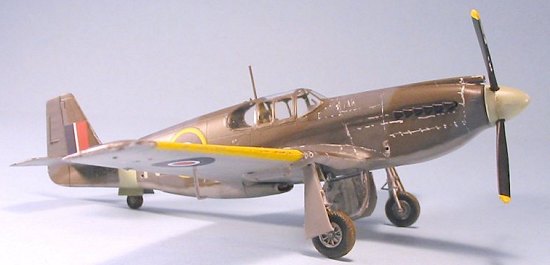 26 Squadron
was the first to operate the Allison Mustang, when it first augmented and
then replaced its Tomahawks with Mustangs in February 1942, though it did
not become operational on the North American fighter until that July;
that April Mustangs replaced Lysanders in 16 Squadron and Tomawhawks in
613 Squadron. By the time of the Dieppe Raid in August 1942, 12 squadrons
were flying the Mustang I, and American Hollis Hills - flying in 414
Squadron RCAF - became the first Mustang pilot to shoot down a German
airplane when he downed a Fw-190A during the operation. In October 1942,
a recon mission to the Dortmund-Ems Canal became the first time an Allied
single-engine fighter had flown from England over Germany. By February
1943, 16 squadrons were equipped with the Mustang, the high point of
Mustang service in the RAF during the war.
26 Squadron
was the first to operate the Allison Mustang, when it first augmented and
then replaced its Tomahawks with Mustangs in February 1942, though it did
not become operational on the North American fighter until that July;
that April Mustangs replaced Lysanders in 16 Squadron and Tomawhawks in
613 Squadron. By the time of the Dieppe Raid in August 1942, 12 squadrons
were flying the Mustang I, and American Hollis Hills - flying in 414
Squadron RCAF - became the first Mustang pilot to shoot down a German
airplane when he downed a Fw-190A during the operation. In October 1942,
a recon mission to the Dortmund-Ems Canal became the first time an Allied
single-engine fighter had flown from England over Germany. By February
1943, 16 squadrons were equipped with the Mustang, the high point of
Mustang service in the RAF during the war.
The Mustang
IA, armed with four cannons, first appeared on operations in August,
1943, followed in late 1943 by the ultimate development of the
Allison-powered Mustang, the Mustang II (P-51A). Already by this time,
Mustang units were being reequipped with Spitfires and other types as the
perceived need for tactical reconnaissance squadrons declined. By the
time of the Normandy invasion, 2nd Tactical Air Force had five Mustang
units: 2 and 268 Squadrons in 35 Wing flying Mustang IAs, and three in 39
Wing - 168, 414 and 430 Squadrons on Mustang Is. Following the invasion,
2 Squadron re-equipped with Mustang IIs. By November 1944, the four
Mustang squadrons still operating took on "Arty " - spotting for Army
artillery - in Holland as the front stabilized. In January 1945, 2
Squadron re-equipped with the Spitfire FR XIVE, and
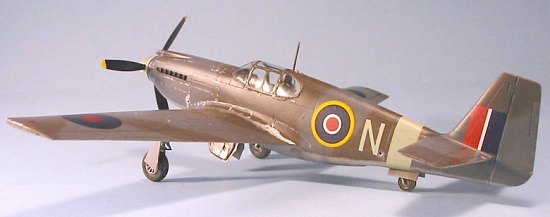 passed their
Mustang IIs along to 268 Squadron, the final user of Allison Mustangs in
the RAF, with one flight of Mustang IAs and one of Mustang IIs. During
Operation Bodenplatte, Flt. Lts. Mercer and Lyle scored the last
aerial victory by Allison Mustangs when they shot down a Ju-188. 268
Squadron soldiered on, moving close to the front in March 1945 for he
Rhine crossings, and continuing Tac-R and artillery spotting missions
until the end of the war. In April 1945, the original Mustang squadron,
26, re-converted to Mustang Is to fly artillery spotting missions for
ships firing on the German positions in Bordeaux. Following V-E Day, the
Allison Mustang rapidly disappeared from RAF service.
passed their
Mustang IIs along to 268 Squadron, the final user of Allison Mustangs in
the RAF, with one flight of Mustang IAs and one of Mustang IIs. During
Operation Bodenplatte, Flt. Lts. Mercer and Lyle scored the last
aerial victory by Allison Mustangs when they shot down a Ju-188. 268
Squadron soldiered on, moving close to the front in March 1945 for he
Rhine crossings, and continuing Tac-R and artillery spotting missions
until the end of the war. In April 1945, the original Mustang squadron,
26, re-converted to Mustang Is to fly artillery spotting missions for
ships firing on the German positions in Bordeaux. Following V-E Day, the
Allison Mustang rapidly disappeared from RAF service.
All of this is to say that there was "plenty of fight" in the first Mustangs, which is to take away nothing from the outstanding achievements of the P-51B and P-51D, which literally won the war in the air over Europe and broke the back of the Luftwaffe, which enabled the Normandy Invasion and the liberation of Western Europe to take place; no small achievement.
|
THE KIT |
Until 1994, the Allison Mustang was ill-served by the kit makers. In 1/72, Frog made an indifferent kit with a wing more appropriate for a P-51D. To date, modelers in 1/72 are still ill-served by the Allison Mustang offerings, which seem unable to determine such basic items as airframe shape, what wing to use, landing gear, etc. Without major scratchbuilding, the 1/72 modeler is out of luck.
 No such
problem exists in 1/48, where Accurate Minatures released the P-51, A-36A
and P-51A as the first products of this company. Additionally, the P-51
was re-released as an RAF Mustang Mk.IA, with different decals and the
camera provided on a separate tree. The only complaints one can have with
these kits is that the propeller is incorrect for any version other than
the P-51A, and is too thick as it appears on the parts tree;
additionally, the instructions are difficult to follow, and some modelers
report difficulty assembling the cockpit into the fuselage due to the
engineering of the kit to allow the creation of different versions.
No such
problem exists in 1/48, where Accurate Minatures released the P-51, A-36A
and P-51A as the first products of this company. Additionally, the P-51
was re-released as an RAF Mustang Mk.IA, with different decals and the
camera provided on a separate tree. The only complaints one can have with
these kits is that the propeller is incorrect for any version other than
the P-51A, and is too thick as it appears on the parts tree;
additionally, the instructions are difficult to follow, and some modelers
report difficulty assembling the cockpit into the fuselage due to the
engineering of the kit to allow the creation of different versions.
The kit comes with differently-molded engine cowlings to cater to the different-shaped carburetor intakes and the weapons carried (or not) in the nose. The wings are different for each, with the P-51 equipped with 4 20mm cannon that extend in front of the wing, the A-36 having four machine guns and dive brakes, and the P-51A having a wing similar to the A-36 minus the dive brakes; there are also different looks in the shape of the radiator scoops between versions. All of these differences are well-met by these kits.
The cockpit provided by the kits is more than acceptable, and set a new standard for the amount and quality of detail expected "in the box" when first released five years ago. True Details released a resin cockpit for the P-51A which has more small detail, without making the original cockpit obsolete in any fashion. The canopy provided, while clear, is quite thick and does not look right at all if it is cut open. Fortunately, Squadron has released vacform canopies of both the "coffin lid" and Malcolm hood which are so beautifully clear that a modeler can leave the canopy hood closed without spoiling any view of the cockpit within.
|
CONSTRUCTION |
Construction of both models began with attaching the particular cowling part to the fuselage halves, prior to gluing the fuselages together; this was because I had discovered when I built other of these kits that fitting the parts was easier at this stage.
 I then moved
on to the cockpits. In the case of the Mustang IA, I decided to use a
True Details resin cockpit I had. Following the painting instructions for
this set, I painted it in Interior Green, with black instrument boxes. I
used the instrument panel decal from the kit on the resin panel. I
decided to use the kit cockpit for the Mustang II,
I then moved
on to the cockpits. In the case of the Mustang IA, I decided to use a
True Details resin cockpit I had. Following the painting instructions for
this set, I painted it in Interior Green, with black instrument boxes. I
used the instrument panel decal from the kit on the resin panel. I
decided to use the kit cockpit for the Mustang II,
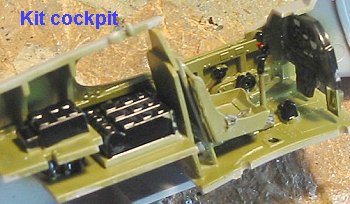 since I was going
to use the Squadron vacuform canopy on this, closed up. I painted the
various parts for this kit's cockpit similarly to that of the other
cockpit. Comparing the two, one can see how simplified the kit cockpit
is, though it certainly looks "good enough" and looks just fine inside a
closed canopy.
since I was going
to use the Squadron vacuform canopy on this, closed up. I painted the
various parts for this kit's cockpit similarly to that of the other
cockpit. Comparing the two, one can see how simplified the kit cockpit
is, though it certainly looks "good enough" and looks just fine inside a
closed canopy.
Since I had a
set of Tamiya Mustang flaps in the spare parts box, I decided to drop the
flaps of the Mustang IA, and so cut the flaps off the wing parts, then
assembled the wings after re-shaping the interior of the upper wing part
so that the flap would fit in the wing. Once the wing was assembled, I
glued the Tamiya flaps in position and they fit perfecly. There was a
bit of cutting and shaping
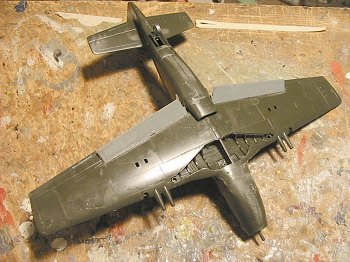 necessary to open up
the flap area under the wing fairing on the fuselage. I left the wing of
the Mustang II with the flaps in the "up" position.
necessary to open up
the flap area under the wing fairing on the fuselage. I left the wing of
the Mustang II with the flaps in the "up" position.
Once the cockpits were finished, the fuselages were glued together and then the fuselage and wing were joined. Fit overall was excellent, and while I had to sand the wing-fuselage joints of both kits for a smooth look, there was no real problem encountered. With that done, I attached the horizontal stabilizers. Both models benefitted from application of Mr. surfacer 500 to all the fuselage seams as well as the upper fuselage-wing joint. When the seams disappeared, the models were ready to go to the paint shop.
The Mustang IA was going to have an open canopy, for which I used the "coffin lid" parts from a Tamiya P-51B, mated with the windscreen and aft windows from the A-M kit. I used the Squadron Mustang vacform canopy for the Mustang II, keeping the canopy closed.
One last item: the kit prop, as I said above, is correct in shape only for the P-51A, the props of the earlier versions being of narrow chord. For this Mustang IA, I used the DeHavilland-blade prop from a Tamiya Spitfire Vb kit I had in the spares box.
|
CAMOUFLAGE & MARKINGS |
Painting:
According to
"Camouflage and Markings: North American Mustang, Northern Europe," the
Mustang IA and II arrived from the factory in "US Equivalent" colors of
ANA603 "Sea Grey" for RAF "Ocean Grey," ANA613 "Dark Olive Drab 42" for
RAF "Dark Green" and ANA602 "Light Grey" for RAF "Sea Grey Medium."
ANA603 "Sea Grey" is equivalent of the contemporary
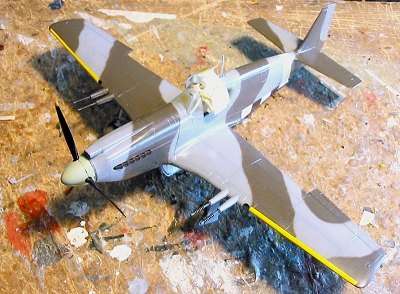 FS36118 "Gunship
Grey," which is quite dark. Additionally, "Dark Olive Drab 42" is a
darker tone than British Dark Green; the result is that these Mustangs
were considerably darker than RAF aircraft. The Mustang IAs had the
ANA603 "Sea Grey" overpainted in RAF Ocean Grey upon arrival, leaving the
Dark Olive Drab and Light Grey camouflage colors. The Mustang IIs, which
were not placed immediately on operations, remained in their darker
colors, and when they were issued to 2 Squadron in June 1944 there was
insufficient time for a repaint, so their entire operational service was
in the "dark scheme."
FS36118 "Gunship
Grey," which is quite dark. Additionally, "Dark Olive Drab 42" is a
darker tone than British Dark Green; the result is that these Mustangs
were considerably darker than RAF aircraft. The Mustang IAs had the
ANA603 "Sea Grey" overpainted in RAF Ocean Grey upon arrival, leaving the
Dark Olive Drab and Light Grey camouflage colors. The Mustang IIs, which
were not placed immediately on operations, remained in their darker
colors, and when they were issued to 2 Squadron in June 1944 there was
insufficient time for a repaint, so their entire operational service was
in the "dark scheme."
Thus, the two models were first "pre-shaded" with flat black airbrushed along panel lines. Additionally, the black D-Day stripes were airbrushed in on the Mustang IA. When that was dry, the black stripes were masked and the white stripes painted - this way is more difficult, doing a light color over a very dark one, but the end result is a more realistic representation of the "temporary" nature of these stripes. When they were dry, the whole area of D-Day stripes were masked off, and the Sky fuselage bands were airbrushed as well as the prop spinners on both kits, as well as painting the wing leading edges yellow and masking them off.
Painting the
Mustang IA, I used Tamiya XF-51 "Khaki Drab" for the ANA613 Dark Olive
Drab, and Tamiya XF-19 "Sky Grey" for the ANA602 Light Grey; I used
Gunze-Sangyo H-337 "Blueish Grey" for Ocean Grey. The scheme was painted
free-hand, since the airplane was re-painted in the field. I used the
"Mustang IA camouflage pattern" as shown in photos and drawings in the
"Camouflage and Markings" booklet.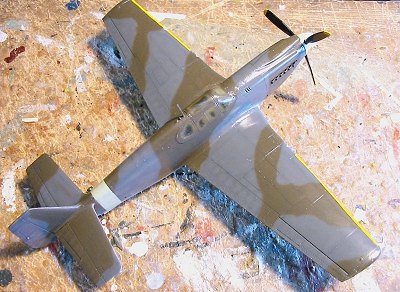
The Mustang II was painted similarly to the Mustang IA, other than I substituted Tamiya XF-24 "Dark Grey" for the Ocean Grey. I used the "Mustang Camouflage Pattern A" from the booklet as a painting guide and also did this freehand.
(It is important to note that there were four different camouflage patterns used on the Mustang I, II and III, as well as a separate scheme all Mustang IAs were painted in, and a separate scheme for the Mustang IV. And there is no set way of deciding which of the four schemes were used on the earlier airplanes, since choice of the scheme appeared entirely random in the factory paint shop. The nice thing is, no Kolourpolizei can bust you, since they can't know either.)
After everything was dry, I unmasked the models and gave each a good coat of Future.
Decals:
The Mustang IA used the decals from the Accurate Miniatures Mustang IA kit that I had not previously used, other than a C1 roundel for the fuselage from the spares box, since the kit decal is incorrectly proportioned. The Mustang II used Techmod decals from a Mustang III sheet, with the serial number made up using the alternate serial on the A-M sheet.
|
FINAL CONSTRUCTION |
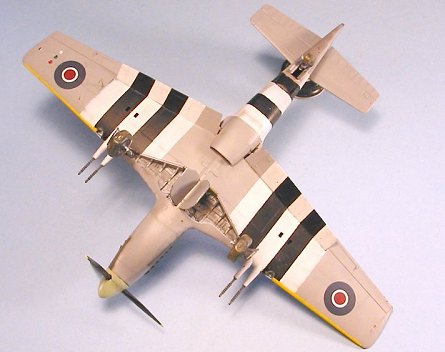 Photographs of
the Mustang IAs serving with 268 Squadron at the time of the Normandy
invasion show the airplanes had been freshly repainted and were kept in a
very clean condition. I thus only applied exhaust staining and some
"scuffing" on the wing where the pilot entered the cockpit.
Photographs of
the Mustang IAs serving with 268 Squadron at the time of the Normandy
invasion show the airplanes had been freshly repainted and were kept in a
very clean condition. I thus only applied exhaust staining and some
"scuffing" on the wing where the pilot entered the cockpit.
I only had one photograph of an RAF Mustang II, this being from 2 Squadron in late 1944, showing a very dirty and dinged airplane. I applied heavier exhaust and gunfire stains, as well as "chipping" the airframe over the areas where it would have been worked on.
|
CONCLUSIONS |
I really like these two RAF "Allison Ponies." They look good sitting next to the Mustang III and IV in my collection. I look forward to the possibility of Accurate Miniatures releasing a Mustang I in the future as they have announced, which will allow me to have the complete line of RAF Mustangs in my collection.
Kits Courtesy Of My Billfold
If you would like your product reviewed fairly and quickly by a site that has over 200,000 visitors a month, please contact me or see other details in the Note to Contributors.